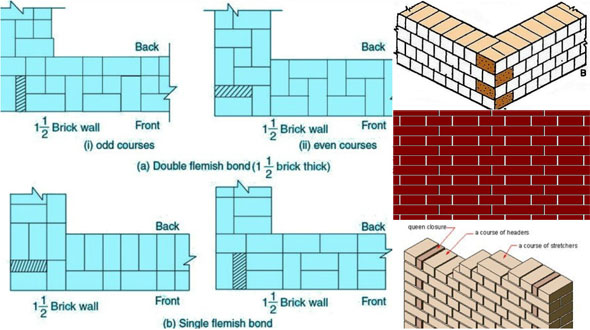Different Types of Bonds in Brick Masonry
- Concrete Cost Estimator
- Concrete Continuous Footing
- Landscape Bidding and Estimating
- Construction Cost Estimating
- Concrete and steel cost estimation
- Construction Cost Estimate Breakdown
- Construction Estimating Worksheet
- Home Construction Cost Estimate
- Estimate Pricing Sheet
- Sheet for General Contractor
- Construction Cost Estimate
- Labor Materials Cost Estimator
- Masonry Estimating Sheet
- Sheet for Building Contractor
- Construction Schedule Bar chart
- General Cost Estimator Sheet
- General Construction Estimate
- Building and Road Estimating Sheet
- Detailed expense estimates
- Door and Window Takeoff Sheet
- General Construction Cost Estimating Sheet

Brick masonry is constructed with bricks that is affixed together with mortar. Mud motar is utilized for temporary sheds whereas lime or cement mortars are employed for all permanent buildings.
The following types of bonds are normally found in brick masonry.
1. Stretcher bond
2. Header bond
3. English bond
4. Flemish bond.
Stretcher Bond: A stretcher belongs to the longest face of the brick found in the elevation. The brick with size of 190 mm × 90 mm × 90 mm, 190 mm × 90 mm, the face remains the stretcher. In stretcher bond masonry all the bricks are placed in stretcher courses. Precaution should be undertaken to split vertical joints. This type of construction is mostly found in the development of half brick thick partition wall.
Header Bond: A header refers to the shorter face of the brick as observed in the elevation. In a standard brick, the dimension of the bond will be 90 mm × 90 mm face. In header bond brick masonry all the bricks are set in the header courses. This type of bond is effective for developing one brick thick walls.
English Bond: In this type of alternate courses, headers and stretchers are included. It is recognized as the hardest bond. It can be applied for the walls having different types of thicknesses. To split coherency of vertical joints, a brick is sliced lengthwise into two halves and applied in the starting and end of a wall after first header. It is known as queen closer.
Flemish Bond: Under this type of bond each course contains alternate header and stretcher. Alternate courses begin with stretcher and header. To split the vertical joints, queen closers are necessary, when a course starts with header. Each header is supported in the middle on the stretcher under it.
Flemish bonds are categorized as follow :-
(a) Double Flemish Bond
(b) Single Flemish Bond.
For double flemish bond, both faces of the wall contain flemish look. It means each course comprises of alternate header and stretcher, while single flemish bond outer faces of walls contain flemish appearance but inner faces appear as English bond.
Superior skill is essential to build up flemish bond. It provides more elegant look. But it does not have good strength as English bond. If only pointing is applied for finished wall, flemish bond is perfect to obtain good artistic view. If plastering is applied, it is recommended to utilize English bond.
Source: www.civilengineeringx.com

- Application of concrete calculator
- Roofing Calculator can streamline the roof estimating process
- House construction cost calculator
- Engineering column design excel spreadsheet
- Material Estimating Sheet with Excel
- Materials List and Cost Estimate Worksheet
- Concrete Slab Estimating Calculator Sheet
- Common types of foundations for buildings
- Online calculation of construction materials
- Estimating with Excel for the Small Contractor
- Concrete Beam Design Spreadsheet
- Virtual Construction Management app for construction
- Autodesk’s Project Skyscraper
- Reed Construction’s Reed Insight
- Manage your construction project documentation
- Costimator, the popular cost estimating software
- On Center Software for construction professionals
- Free Construction Estimating Software
- Plumbing Calc Pro
- Cost Estimate Worksheet
- HVAC Piping Quantity Takeoff Worksheet
- Construction Estimating Software Sheet
- Estimate Cost Templates
- Construction Punch List
- Construction cost estimating template consisting estimating basic
- Gantt Chart Template for Excel
- Download Civil Engineering Spreadsheets with Verification
- The Building Advisor Estimating and Budgeting Worksheet
- Spreadsheet for design of concrete bridge
- Construction Estimating Software Free








